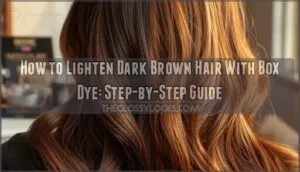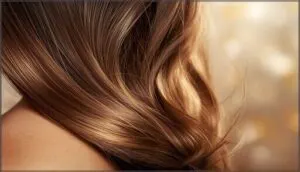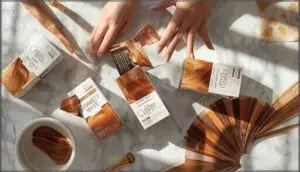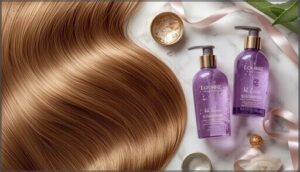This site is supported by our readers. We may earn a commission, at no cost to you, if you purchase through links.
 You stare at the box dye, wondering if it’s really possible to go from dark brown to honey blonde without stepping foot in a salon. The truth is, box dye can lighten your hair—but it won’t deliver the dramatic transformation you see on the package.
You stare at the box dye, wondering if it’s really possible to go from dark brown to honey blonde without stepping foot in a salon. The truth is, box dye can lighten your hair—but it won’t deliver the dramatic transformation you see on the package.
Most formulas lift virgin hair only one to two levels, which means your deep brunette might become a medium brown at best. The secret isn’t in finding a magic product; it’s in understanding how hair lightening actually works and setting realistic expectations from the start.
With the right approach, you can gradually brighten your dark brown hair and avoid the brassy disasters that come from pushing too hard, too fast.
Table Of Contents
Key Takeaways
- Box dye can lift dark brown hair only 1–2 levels per session (maybe 3–4 with high-lift formulas), so you won’t get honey blonde in one go—patience and spacing sessions 6–8 weeks apart prevents damage while gradually building toward your goal shade.
- Matching your skin’s undertones (cool veins = ash tones, warm veins = golden tones) improves how flattering your new color looks by up to 28%, making the difference between “this works” and “this really works.”
- Toners are non-negotiable for neutralizing the orange and yellow brassiness that sneaks in after lightening, using violet pigments to balance unwanted warmth without causing additional damage.
- Protecting lightened hair with sulfate-free shampoos, heat protectants, and weekly protein treatments extends color vibrancy by 45% and reduces breakage, keeping your new shade looking fresh longer.
Can I Dye My Hair Lighter Without Bleach?
Can you realistically lighten dark brown hair with box dye alone, without bleach? The short answer: not much. Box dye generally lifts virgin hair just 1–2 levels, maybe 3–4 with high-lift formulas containing ammonia. But if your hair’s already been colored, don’t expect change—color can’t lift color.
Consumer dissatisfaction runs high for a reason: most people hoping for blonde end up disappointed. Ammonia alternatives like MEA don’t deliver the same lift, and damage risks increase with repeated attempts. For significant lightening, bleach remains your best bet.
However, for those with dark hair, you can still achieve color by using temporary hair dye.
Tips for Lightening Dark Brown Hair
Lightening dark brown hair with box dye isn’t quite as simple as picking your favorite shade and hoping for the best. You’ll get better results when you work with your hair’s natural pigment instead of against it.
Here are two key strategies that’ll help you avoid brassy tones and protect your strands while you lighten.
Gradually Lighten Hair
Before diving into lightening dark brown hair, know this: patience is your best friend. Permanent box dye with a 20-volume developer generally lifts 1–2 levels per session—standard formulas reach their limit after one round, since artificial pigment blocks further penetration. That’s why cumulative lightening works: spacing sessions 6–8 weeks apart lets your hair recover protein and lipid structure while gradually building toward your goal shade. The developer’s hydrogen peroxide activates the dye molecules for color to deposit.
Here’s your roadmap for minimizing damage:
- Choose 20-volume developer for gentle, controlled lift without excessive cuticle stress
- Assess your porosity impact—damaged hair absorbs dye faster but also dries out quicker
- Pre-treat with coconut oil to reduce protein loss by up to 30% during color processing
- Focus midshaft to ends on previously lightened sections to avoid harsh demarcation lines
This gradual process respects your hair’s limits while delivering real results.
Use Toners
Once your box dye lifts your dark brown hair, brassiness often sneaks in—orange and yellow undertones that scream “I tried.” That’s where toners step in. These demi-permanent formulas deposit sheer pigments that neutralize unwanted warmth without further lightening. Blue toners tackle orange in brunettes, while purple shampoos eliminate yellow in lighter shades.
After box dye lifts dark hair, toners neutralize the brassy orange and yellow tones that scream amateur hour
Application methods are straightforward: section damp hair, apply evenly, wait five to ten minutes, rinse. Toning frequency matters—space sessions four to five weeks apart to prevent dryness.
The chemical composition relies on violet dyes like CI 60725 to absorb complementary hues, balancing your hair color while boosting shine and protecting hair health post-dye.
Choosing The Right Box Dye
Picking the right box dye can feel like standing in the hair care aisle forever, staring at a hundred different boxes. But here’s the truth: not all box dyes are created equal, and what works for your friend mightn’t work for you.
Let’s break down two key factors that’ll help you choose a shade that actually flatters your features and lasts the way you want it to.
Complement Your Skin Tone
Your skin’s undertones hold the secret to choosing the right box dye when you lighten dark brown hair. Check your wrist veins—blue or purple signals cool tones that pair beautifully with ash browns or platinum, while green veins reveal warm tones that shine with golden browns or strawberry blondes. Neutral shades like sandy blonde or mocha brown work for those in between.
This undertone matching isn’t just aesthetic preference—proper complementing skin tone improves complexion evenness by up to 28%. Test shades against your jawline before committing, and you’ll discover a harmonious, natural-looking transformation.
Permanent Vs Semi-Permanent
When you lighten dark brown hair with box dye, choosing between permanent vs semipermanent dye shapes your entire journey. Permanent dye uses ammonia and peroxide to lift pigment up to three levels, delivering that dramatic transformation you’re after. Semipermanent formulas coat the surface without developer, offering zero-damage color that fades gracefully over 4–12 washes.
Consider these key differences:
- Gray coverage: Permanent achieves 100% concealment while semipermanent only blends
- Color longevity: Permanent lasts months with touch-ups; semipermanent fades in 2–6 weeks
- Damage comparison: Permanent alters keratin structure; semipermanent maintains natural integrity
Your hair’s current condition and color goals will guide your choice.
Preparing Your Hair Before Dyeing
Before your dye appointment with yourself, let’s talk prep work—because great color starts days before you crack open that box.
Start by checking your hair’s current state. If it’s feeling crispy or showing damage, treat it to a deep conditioning mask 48 hours before dyeing. Protein treatments can boost your hair’s strength by about 22%, giving it resilience against the chemical process ahead.
Here’s your game plan:
| Timing | Action |
|---|---|
| 3-7 days before | Apply moisture masks if hair is dry or damaged |
| 24-48 hours before | Wash with clarifying shampoos to remove product buildup (they eliminate up to 98% of residue!) |
| Day of dyeing | Skip styling products—they block dye absorption by 18-25% |
| Always | Do a patch test 48 hours prior to avoid allergic reactions |
Those natural scalp oils you’ve got going? They’re actually protecting you, reducing irritation by over 45%. Smart prep means better color and healthier hair.
Applying The Box Dye
Once your prep work’s done, it’s time for the main event. Grab your at-home hair dye kit and divide your hair into 4 to 6 equal sections—sectioning techniques matter more than you think, since uneven coverage can create brightness variations of up to 40%.
Start your root application first, where your body heat helps activate the formula faster, then work through to your ends. Saturation uniformity is your goal here: make sure every strand is fully coated within 10 minutes of mixing to avoid one of the most common hair dyeing mistakes—patchy color. Comb through every 5 to 7 minutes during reaction timing (usually 35–45 minutes).
When the clock’s up, post-dye rinsing with cool water closes those lifted cuticles and locks everything in place. You’ve got this!
Caring for Lightened Hair
Once you’ve lightened your hair, the real work begins—keeping that fresh color vibrant and your strands healthy. Your hair’s been through a lot, so it needs some extra love to stay strong and shiny.
Let’s talk about the key steps that’ll help you protect your new look and prevent damage down the road.
Color-Treated Products
Your freshly lightened strands deserve specialized protection. Sulfate-free shampoos extend color vibrancy by 45% compared to traditional formulas, preventing premature fading. Pair them with hydration conditioners enriched with glycerin and amino acids to boost tensile strength by 22%.
Heat protectants and UV protection sprays are non-negotiables—they reduce damage by 30–40% while shielding your new hue from sun exposure. Add protein restoration treatments weekly to rebuild bonds weakened during dyeing.
These color-treated hair essentials keep your lightened locks radiant longer.
Gloss Treatments
Think of gloss treatments as the finishing glaze on your masterpiece—they seal the deal on vibrant, dimensional color. After box dye application on dark brown hair, a quality gloss treatment penetrates the cuticle to lock in hair color while boosting shine by up to 40%.
Look for glosses with panthenol and plant proteins—they’ll reduce dryness and breakage while amplifying your lightening results. Application techniques are simple: shampoo, apply evenly, wait 20 minutes, rinse.
These DIY gloss formulas last 4–6 weeks, keeping your newly lightened strands looking salon-fresh without the damage of repeated hair lightening sessions.
Frequently Asked Questions (FAQs)
How long between lightening sessions is safe?
Wait at least 4-6 weeks between sessions—your hair needs time to rebuild strength and repair internal damage. Hair porosity and initial condition determine your recovery timeline, so assess damage severity before scheduling another lightening session.
Can box dye fix orange or brassy tones?
Orange tones feel like warning lights on your hair journey.
Box dye with ash or toner can neutralize brassiness temporarily, but proper application techniques and ongoing maintenance routines prevent tone reversion within weeks.
Does hair porosity affect lightening results significantly?
Yes, porosity level impact is significant. High-porosity hair strands absorb lightener faster, risking more hair damage. Low-porosity hair cuticles resist penetration, requiring longer processing. Understanding your hair porosity ensures consistent results achievement.
What if my roots lighten faster than ends?
Your roots lighten faster because scalp heat accelerates the lightening process.
Combat hot roots by applying box dye to mid-lengths first, then roots last. This timing trick prevents uneven lightening during hair color application.
Should I do a strand test first?
Absolutely—a strand test is your safety net. It reveals color predictability, damage assessment, and allergy detection before full application.
Test a hidden section for 30 minutes, then evaluate base color results after 24 hours.
Conclusion
Lightening dark brown hair with box dye won’t turn you into a sun-kissed goddess overnight, but it can absolutely shift your color in the right direction. The real magic happens when you work with your hair instead of against it—lifting gradually, protecting your strands, and embracing the journey.
You’ve got the roadmap now. Take it slow, stay patient, and watch your transformation unfold one shade at a time.
- https://www.glamot.com/blog/34895/all-about-hair-lightening-bleaching
- https://www.reddit.com/r/hairstylist/comments/1jipvsz/ammonia_vs_ammonia_free_color/
- https://www.medicalnewstoday.com/articles/does-dye-damage-hair
- https://www.revlonprofessional.com/blog/correct-black-box-dyed-hair/
- http://www.advancedcoloration.com/acblog/ammonia-non-ammonia-professional-hair-color-real-facts/







